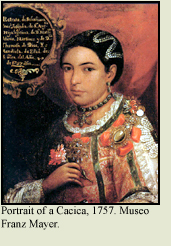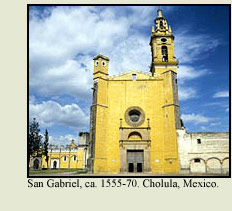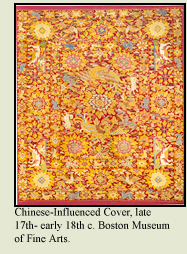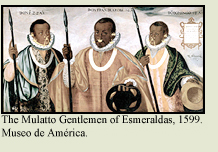|
The
city street, the nun’s cell, and the gentleman’s
chamber—these spaces framed daily life in Spanish
America. So too did the local church, the indigenous
house, and the market. Today, these sites and the
things that people created for them suggest the ways
that visual culture in Spanish America was patterned
by the mundane and regular as well as spontaneous
rhythms of everyday life.
 People
in Spanish America, like people in Spain, held cities
to be the source of civilized life, and it was in
cities that a distinct visual culture was first shaped.
The Spanish American city, for instance, was to be
set out on a grid—that is, adhering to an ideal
Renaissance city plan. This physical space was further
modified by social and political ideals. Spaniards
made idealized divisions in their colonies between
separate “republics” of different peoples,
each with different roles and responsibilities. In
the ideal of the city, they were to be carefully segregated
(although, in practice, strict segregation rarely
occurred). The elite home, the convent, the monastery
likewise, were to be worlds whose architecture would
set them apart from the bustle of the marketplace
and the rowdiness of city streets. These interior
spaces, in turn, were intended to mold inhabitants
and shape the practice of everyday life. People
in Spanish America, like people in Spain, held cities
to be the source of civilized life, and it was in
cities that a distinct visual culture was first shaped.
The Spanish American city, for instance, was to be
set out on a grid—that is, adhering to an ideal
Renaissance city plan. This physical space was further
modified by social and political ideals. Spaniards
made idealized divisions in their colonies between
separate “republics” of different peoples,
each with different roles and responsibilities. In
the ideal of the city, they were to be carefully segregated
(although, in practice, strict segregation rarely
occurred). The elite home, the convent, the monastery
likewise, were to be worlds whose architecture would
set them apart from the bustle of the marketplace
and the rowdiness of city streets. These interior
spaces, in turn, were intended to mold inhabitants
and shape the practice of everyday life.
 Often,
separate spaces were set up for or by women, a byproduct
of a culture that valued female chastity, domesticity,
and spirituality and held them apart from the values
and practices of more traditionally public and masculine
spheres. For instance, a convent of cloistered nuns
was seen as largely a female world, protected by thick
fortress-like walls from mundane intrusions. And the
elite house also created careful distinctions between
home and the world. In Count Xala’s 18th-century
mansion in Mexico City, for instance, the street level
resounded with the tramp of horses and rattle of carriages
as business was carried out, but the upper floor was
reserved for family and friends. It may be hard to
imagine today, but the women of the Xala family would
spend most of their time, even their lives, on this
floor. Often,
separate spaces were set up for or by women, a byproduct
of a culture that valued female chastity, domesticity,
and spirituality and held them apart from the values
and practices of more traditionally public and masculine
spheres. For instance, a convent of cloistered nuns
was seen as largely a female world, protected by thick
fortress-like walls from mundane intrusions. And the
elite house also created careful distinctions between
home and the world. In Count Xala’s 18th-century
mansion in Mexico City, for instance, the street level
resounded with the tramp of horses and rattle of carriages
as business was carried out, but the upper floor was
reserved for family and friends. It may be hard to
imagine today, but the women of the Xala family would
spend most of their time, even their lives, on this
floor.
 Models
of female roles were conveyed and reflected in visual
images. Portraits of elite women showed them as wives
of powerful men, daughters of wealthy families, usually
ripe for marriage, or brides of Christ. While this
depiction of a sixteen-year-old indigenous woman shows
her holding a flower and a fan, other portraits emphasized
and promoted female religiosity; even in secular portraits,
women grasp rosaries, as if the artist had interrupted
them at prayer. Models
of female roles were conveyed and reflected in visual
images. Portraits of elite women showed them as wives
of powerful men, daughters of wealthy families, usually
ripe for marriage, or brides of Christ. While this
depiction of a sixteen-year-old indigenous woman shows
her holding a flower and a fan, other portraits emphasized
and promoted female religiosity; even in secular portraits,
women grasp rosaries, as if the artist had interrupted
them at prayer.
 But
religiosity was not only the province of women, and
almost everyone participated in some degree in religious
life. Men, as bishops, monks, or cofradía members,
were typically the leaders of organized religion.
And the tempo of the days—in metropolitan centers
and native communities alike—was set by the
Catholic Church, where the vivid eruption of feasts
and saints’ days overlaid the regular pattern
of the seven-day week, with Sunday at its lead. But
religiosity was not only the province of women, and
almost everyone participated in some degree in religious
life. Men, as bishops, monks, or cofradía members,
were typically the leaders of organized religion.
And the tempo of the days—in metropolitan centers
and native communities alike—was set by the
Catholic Church, where the vivid eruption of feasts
and saints’ days overlaid the regular pattern
of the seven-day week, with Sunday at its lead.
 While
buildings and objects show us the contours of powerful
ideologies, the messy practice of living has also
left its residue in the objects and places of everyday
life. While some maps of the cities of Spanish America
display grid plans and segregated neighborhoods, in
actual neighborhoods, Spaniards, Indians, mulattos
and mestizos lived cheek by jowl. Convent, monastery
and elite households offered spacious quarters for
their wealthy residents, and then tiny cells or rooftop
shacks for the servants who came and went to markets
and public spaces. Despite imposing façades,
these buildings were places open to the world. While
buildings and objects show us the contours of powerful
ideologies, the messy practice of living has also
left its residue in the objects and places of everyday
life. While some maps of the cities of Spanish America
display grid plans and segregated neighborhoods, in
actual neighborhoods, Spaniards, Indians, mulattos
and mestizos lived cheek by jowl. Convent, monastery
and elite households offered spacious quarters for
their wealthy residents, and then tiny cells or rooftop
shacks for the servants who came and went to markets
and public spaces. Despite imposing façades,
these buildings were places open to the world.
 Ideals
about social roles conjoined with everyday practices
to shape the visual environment, as did available
materials. This section of Vistas includes
objects that are distinct to Spanish America, often
because of available products and materials. The glorious
tapestries made in Peru, like this cover for a table
or bed, were woven of local cotton and the wool gathered
from llamas and vicuñas. This cover’s
color comes from cherry-red cochineal, a dye made
from the bodies of crushed insects that had been in
use since pre-Columbian times. A silver teapot called
a pava was designed to brew tea made out of maté
leaves, a popular drink then and now. The heavy and
nearly pure silver used in this and other objects,
like the coffeepot shown below, came from rich mines
in northern Mexico and Bolivia. Ideals
about social roles conjoined with everyday practices
to shape the visual environment, as did available
materials. This section of Vistas includes
objects that are distinct to Spanish America, often
because of available products and materials. The glorious
tapestries made in Peru, like this cover for a table
or bed, were woven of local cotton and the wool gathered
from llamas and vicuñas. This cover’s
color comes from cherry-red cochineal, a dye made
from the bodies of crushed insects that had been in
use since pre-Columbian times. A silver teapot called
a pava was designed to brew tea made out of maté
leaves, a popular drink then and now. The heavy and
nearly pure silver used in this and other objects,
like the coffeepot shown below, came from rich mines
in northern Mexico and Bolivia.
 Class
also played a definitive role in the creation of visual
culture and in subsequent understandings of it. Elites
were not the only ones to document their lives and
possessions through legal contracts and wills, but
more of their papers survive, as do their diaries,
travel accounts and spiritual biographies. The objects
the wealthy owned and commissioned, because of their
durable and often precious materials, are also the
ones most likely to have been passed down and preserved
through generations. Reflecting the higher survival
rate of elite documents, objects and architecture,
Vistas by default offers a clearer picture
of high-status lives and spaces. Surviving elite objects
from Spanish America register the powerful influence
of both Spanish and broader European traditions. Style
and function, in particular, suggest how much the
upper classes in Spanish America admired and emulated
the visual culture of Spain. Their campaign to import
European things and ideas into the New World was helped
by presence of large cities. For new ideas spread
quickly within these concentrated milieus, and then
made their way outward to more provincial towns and
communities. Class
also played a definitive role in the creation of visual
culture and in subsequent understandings of it. Elites
were not the only ones to document their lives and
possessions through legal contracts and wills, but
more of their papers survive, as do their diaries,
travel accounts and spiritual biographies. The objects
the wealthy owned and commissioned, because of their
durable and often precious materials, are also the
ones most likely to have been passed down and preserved
through generations. Reflecting the higher survival
rate of elite documents, objects and architecture,
Vistas by default offers a clearer picture
of high-status lives and spaces. Surviving elite objects
from Spanish America register the powerful influence
of both Spanish and broader European traditions. Style
and function, in particular, suggest how much the
upper classes in Spanish America admired and emulated
the visual culture of Spain. Their campaign to import
European things and ideas into the New World was helped
by presence of large cities. For new ideas spread
quickly within these concentrated milieus, and then
made their way outward to more provincial towns and
communities.
 Through
time, the visual culture of Spanish America, first
colored by transatlantic trade, picked up a distinct
tincture from transpacific commerce. The galleons
that were loaded down with New World silver returned
from Asia carrying Chinese silks and blue-and-white
porcelain. By the 18th century, elite homes were likely
to have Spanish-inspired chests inlaid with bone alongside
Asian-inspired lacquered furniture and ceramics, all
made by local artists and craftsmen. So attractive
was this urban elite visual culture that even places
on the far frontiers picked up its pulses like signals
on a radio, as urban products and ideas were transmitted
along internal trade routes. Along the dusty Chihuahua
trail in New Mexico, wealthy residents of Santa Fe
wore imported European brocade and ate off painted
pottery from Puebla, just as did their counterparts
in Mexico City, thousands of miles away. Through
time, the visual culture of Spanish America, first
colored by transatlantic trade, picked up a distinct
tincture from transpacific commerce. The galleons
that were loaded down with New World silver returned
from Asia carrying Chinese silks and blue-and-white
porcelain. By the 18th century, elite homes were likely
to have Spanish-inspired chests inlaid with bone alongside
Asian-inspired lacquered furniture and ceramics, all
made by local artists and craftsmen. So attractive
was this urban elite visual culture that even places
on the far frontiers picked up its pulses like signals
on a radio, as urban products and ideas were transmitted
along internal trade routes. Along the dusty Chihuahua
trail in New Mexico, wealthy residents of Santa Fe
wore imported European brocade and ate off painted
pottery from Puebla, just as did their counterparts
in Mexico City, thousands of miles away.
 Because
of the predominance of elite objects among survivals,
it is possible to mistake elite culture and urban
culture for all of visual culture, but this is far
from the case. Rural areas and small towns lay at
a distance from the network of cities and the pulses
of international trade. Here, the particulars of geography,
available materials, and the inheritance of distinct
native traditions were more strongly felt. While it
might be easy at first to mistake a coffee pot from
Lima for one from Mexico City, it would be impossible
to confuse a set of woman’s clothes from Cuzco,
Peru with one from Antigua, Guatemala. Because
of the predominance of elite objects among survivals,
it is possible to mistake elite culture and urban
culture for all of visual culture, but this is far
from the case. Rural areas and small towns lay at
a distance from the network of cities and the pulses
of international trade. Here, the particulars of geography,
available materials, and the inheritance of distinct
native traditions were more strongly felt. While it
might be easy at first to mistake a coffee pot from
Lima for one from Mexico City, it would be impossible
to confuse a set of woman’s clothes from Cuzco,
Peru with one from Antigua, Guatemala.
 In
rural areas and small towns, it was regional markets,
offering local products, both natural and man-made,
that allowed for the development and expression of
local taste. This woven bag, created in an Andean
town, suggests that aesthetic choices were never limited
to urban centers. Whether this bag was made for sale
in a market or as a personal gift for an indigenous
man or woman is no longer known. Yet regional markets—in
the Andes and elsewhere—had a long history,
dating to well before the arrival of Europeans. Indeed
many survive today. While the physical appearance
of colonial markets rarely exists, the occasional
surviving document offers a glimmer of the market
spectacle and hints at the visual culture of ordinary
lives. As to the range of local styles that once came
out of these markets, perhaps the best visual clues
emerge in the spectrum of contemporary folk arts from
Latin America, and in its craft traditions that are
some of the richest in the world. In
rural areas and small towns, it was regional markets,
offering local products, both natural and man-made,
that allowed for the development and expression of
local taste. This woven bag, created in an Andean
town, suggests that aesthetic choices were never limited
to urban centers. Whether this bag was made for sale
in a market or as a personal gift for an indigenous
man or woman is no longer known. Yet regional markets—in
the Andes and elsewhere—had a long history,
dating to well before the arrival of Europeans. Indeed
many survive today. While the physical appearance
of colonial markets rarely exists, the occasional
surviving document offers a glimmer of the market
spectacle and hints at the visual culture of ordinary
lives. As to the range of local styles that once came
out of these markets, perhaps the best visual clues
emerge in the spectrum of contemporary folk arts from
Latin America, and in its craft traditions that are
some of the richest in the world.

|
